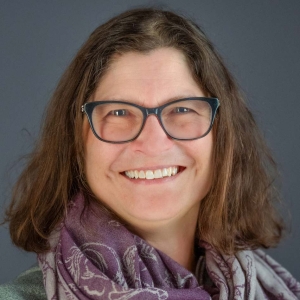When things turn bleak for Emmet and friends in “The Lego Movie 2: The Second Part,” the opening lines of the song “Everything’s Not Awesome” brilliantly capture the mood:
“I finally understand Radiohead.”
Since its formation in the mid-1980s in the English county of Oxfordshire, the rock band’s melancholic aesthetic, grounded in the danger and mystery surrounding hope and death, has made them one of the most popular and critically acclaimed bands in the world.
The latest milestone occurs next month when Radiohead is inducted into the Rock and Roll Hall of Fame, even though, true to form, they are unlikely to show up.
The experimental band’s constantly evolving sound (the New Yorker once claimed the band “is taken as seriously as any since the Beatles”) is the focus of a unique course this winter at Union, “The Art and Music of Radiohead.”
The 10-week upper-level course is taught by Professor Jennifer Milioto Matsue, an ethnomusicologist and former chair of the Popular Music Section of the Society of Ethnomusicology (SEM), the largest national organization devoted to the study of popular music.
Each week, students explore one of the band’s nine studio albums, from 1993’s “Pablo Honey” to their latest, 2016’s “A Moon Shaped Pool.”
Topics include “Radiohead and the Negation of Gender,” Deforming Rock: Radiohead’s Plunge into the Sonic Continuum,” and “We got Heads on Sticks/You got Ventriloquists: Radiohead and the Improbability of Resistance,” culled from one of three required books for the course, including “The Music and Art of Radiohead” by Joseph Tate.
Students also will watch 1998’s “Meeting People is Easy,” a Grammy-nominated documentary chronicling Radiohead’s world tour in support of “OK Computer,” and a live concert film.
“Through the study of the art and music of Radiohead, I hope the students gain a great appreciation for the richness of rock and roll as a vehicle through which we can explore the social and sonic, aesthetics, capitalism and the political machinations of the past 25 years,” said Matsue, director of the World Musics and Cultures Program and professor, departments of Music, Asian Studies and Anthropology.
Matsue’s research skews toward popular music. She is the chair of the Japanese Performing Arts Special Interest Group of SEM. Her 2015 book, “Focus: Music in Contemporary Japan,” examined a wide range of music performed in Japan, from traditional to popular styles, through the lens of adaptation.
The idea to offer an academic course focused on Radiohead and its influence grew out of a popular class Matsue has taught in the past, “The History of Rock and Roll: From Rhythm and Blues to Radiohead.”
But the class isn’t only a deep dive into the band by listening to its albums, watching music videos or reading essays. Working closely with Cole Belmont, the director of the College’s Makerspace consortium, students are preparing a diverse list of projects as part of their final.
With the assistance of Lee Walis, coordinator of Learning Environments Services, two students plan to write and record a four-song EP that explores the concept of exclusion. Another student is creating a song focused on the complexity of meter and rhythm. One will travel 50 years into the future to find lead singer Thom Yorke's obituary for a multimedia presentation. Several projects will feature 3D modeling and printing focused on ecology and society. And there will be a full-on fashion show with costumes designed to reflect Radiohead's overall oeuvre and three representative albums.
Students will present their projects Thursday, March 14, from 2 to 4 p.m. in Emerson Auditorium in the Taylor Music Center.
“Just like Radiohead, this class has blossomed into a magnificent collaborative creative project, bringing together students of varied backgrounds who are making music, 2-dimensional visual art, 3-D printed models, poetry, fiction, film and even fashion,” said Matsue.
Bridget Cunningham ‘21 has been listening to Radiohead since middle school. Like many fans, she was introduced to the band when she saw a YouTube clip of the breakout song “Creep.” Last summer, she saw the group live for the first time at Madison Square Garden, which she called “an immersive experience.”
Cunningham knows many people don’t get the group’s appeal, in part because it’s hard to define what they play. As the New Yorker stated, “Radiohead remain a magnet for misfits everywhere, but their outsider status is only a part of their appeal.”
The course may help explain why a group with its well-known disdain for commercialism has managed to sell more than 30 million records.
“Radiohead has a different approach to rock music that I can’t really explain,” said Cunningham, a computer science and digital media interdepartmental major from West Orange, N.J.
“You don’t play their music at parties. You listen to it by yourself and appreciate the creativity. It can bring you to another state of mind. And that can be very therapeutic.”

